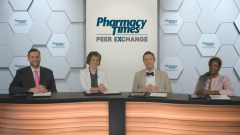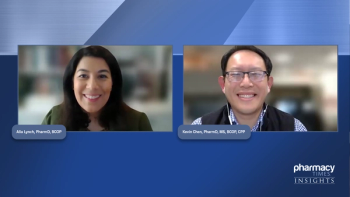
Evolution of RSV Treatment Strategies
Mary Bridgeman, PharmD, BCPS, BCGP, FASCP, Adam C. Welch, PharmD, MBA, FAPhA, and Christina Madison, PharmD, FCCP, AAHIVP, discuss the testing and treatment strategies for RSV.
Episodes in this series

Ryan Haumschild, PharmD, MS, MBA: Let’s talk about managing RSV [respiratory syncytial virus] infections. Ms Bridgeman, how have RSV treatment and prevention strategies evolved? What role do we have as health care providers in preventing and treating these infections, specifically in adults?
Mary Bridgeman, PharmD, BCPS, BCGP, FASCP: Historically, there hasn’t been strong treatment guidance for managing RSV in adults. Like most viral illnesses, our treatment approach usually encompasses supportive care and symptomatic management for whatever symptoms patients present with. Some major recent updates are related to the development of several, albeit 2 that are closest to the finish line of availability. One is the first FDA-approved vaccine licensed for treatment in adults aged 60 and older to prevent severe RSV infections. As health care providers, we play a tremendous role in reducing the spread of RSV infections, particularly in the health care setting. In the hospital where I practice, we know nosocomial spread is possible. And those principles of infection prevention and control practices are critical in reducing the transmission of this respiratory viral illness.
Ryan Haumschild, PharmD, MS, MBA: A lot of the strategies that you described play into our public health theme. What can we do more broadly to create more awareness of RSV, have better habits, and make it a priority, as the CDC [Centers for Disease Control and Prevention] and other organizations have done? Mr Welch, you play a huge role in public health and the awareness around vaccines. How can public health efforts be improved to reduce the burden of RSV in adults?
Adam C. Welch, PharmD, MBA, FAPhA: We learned a lot from COVID-19. There are some things that we’ve learned as a society that we may not realize we’ve learned. For example, we’ve normalized the idea of hand sanitizer with COVID-19. Individuals are carrying it. Children are carrying it to school, and it’s readily available. That simple act of removing the virus through hand sanitizer is a prevention strategy that we could use for RSV. Individuals seek primary care family medicine when they’re ill or have upper-respiratory symptoms. They get tested to see if they can get an antibiotic or if it’s something viral. If it’s something viral, prevention strategies—like handwashing and avoiding close contact—work across all respiratory viruses. If we can use it for COVID-19, then we can use the same prevention strategies for the flu and RSV. We have testing available for COVID-19, flu, and RSV, but we’re not utilizing it as much as we could be. We can have more detailed information. Treatments are mainly symptomatic, but as more become available, we can begin to specify that treatment.
Unfortunately, with some of the tests we’re using—for example, the antigen test—in adults who may have been exposed to RSV several times in their lifetime, they may not have the antigen load that children would have if they’ve been exposed for the first time or for a few times. You’re going to see a lot more false negative tests in adults using an antigen nasal test. But the PCR [polymerase chain reaction] test is going to be a little more accurate in the adult population. From a public health standpoint, increased testing will give us more information that we need. The standard of treatment is symptomatic. But prevention is going to be important through vaccination, which we’ll talk about.
Christina Madison, PharmD, FCCP, AAHIVP: I love that you brought up the possibility of having a false negative because this is something that comes up all the time. We see that with the flu as well. [We need to] make sure patients know that when they test, even if it comes back negative, that doesn’t automatically rule out infection.
Adam C. Welch, PharmD, MBA, FAPhA: It becomes important when you’re testing, whether it’s positive or negative, when think about vulnerable populations, like long-term care facilities. If someone has viral symptoms of upper-respiratory infection, they need to be isolated from the other residents within that facility because of the risk of spread. Whether it’s flu, COVID-19, or RSV, that’s an important preventive.
Ryan Haumschild, PharmD, MS, MBA: You bring up a great point. We’re seeing the baby boomer population continue to be in assisted living and independent living facilities and even skilled nursing in nursing homes. You’re seeing RSV outbreaks. Are individuals are watching and thinking about how we minimize or contain emerging breakouts of RSV in these facilities? How do we do that safely to prevent the spread to other healthy individuals or healthy vulnerable populations like older adults?
Adam C. Welch, PharmD, MBA, FAPhA: For these facilities, the policies that were in place for COVID-19 prevention and that are in place for influenza prevention can apply to RSV. It’s just a matter of creating that awareness that RSV is a detectable disease and a disease that will have a vaccine to prevent. We need to implement similar policies for RSV.
Christina Madison, PharmD, FCCP, AAHIVP: With respiratory precautions, we have a much lower threshold for implementing those than we did before. I come from the tuberculosis world, where we would see somebody on the back end come back positive and say, “Oh my goodness.” We’re much quicker to implement those respiratory precautions, especially in skilled nursing facilities and places where we could see a huge spread of infection in a short period of time. The incubation period is 3 to 8 days. When we think about viral spread, that’s an eternity compared with some of our other respiratory viral pathogens.
Mary Bridgeman, PharmD, BCPS, BCGP, FASCP: Sometimes symptoms trump the test.
Christina Madison, PharmD, FCCP, AAHIVP: Exactly.
Mary Bridgeman, PharmD, BCPS, BCGP, FASCP: We also think about that delay in obtaining test results and perhaps being a little proactive with regard to isolation and implementing those precautions.
Transcript edited for clarity.
Newsletter
Stay informed on drug updates, treatment guidelines, and pharmacy practice trends—subscribe to Pharmacy Times for weekly clinical insights.







































































































































































































